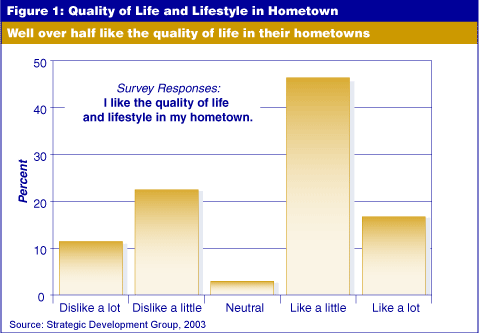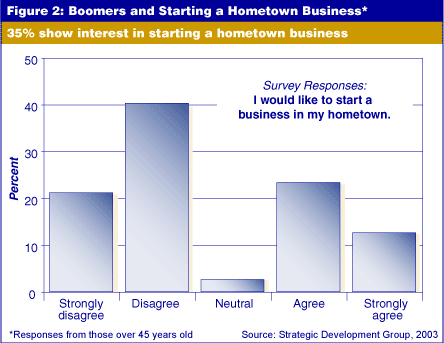Baby Boomers May Be Eyeing Hometowns
There is a topic commanding more and more attention among community leaders these days. As elected officials, businessmen, social service providers, educators and others discuss their problems and opportunities, hardly a conversation ends without the mention of brain drain.
Though no one has adopted a formal definition for brain drain, it can be described as the continual out-migration of a geographic area’s best and brightest students. It is most prevalent among smaller and rural communities, but also occurs in inner-city urban areas and across entire countries.
The worst part about the domestic brain drain is that generally no significant counteractive brain gain occurs as new residents move into smaller and rural communities. Despite the fact that high schools are sending increasingly high numbers of students to post-secondary education, it is difficult, if not impossible, to raise the average educational level of small town America. As a result, there is less brain power available to advance businesses, solve local problems and mentor younger generations.
Economic and community development pundits have rightfully pointed to the lack of appropriate employment and wages as the culprit. Their opinions can be backed up by a look at employment patterns and salaries for workers in the affected communities.
Research by the Strategic Development Group (SDG) indicates that the younger generation has concluded that it would be difficult to find an appropriate job at a reasonable rate of pay in their hometowns. So community leaders have determined that by creating better jobs and raising wages, the brain drain might be slowed—maybe even reversed. Unfortunately, it may be quite the challenge to put reins on young, intelligent and ambitious people who want to not only see the world, but make their mark on it.
SDG’s research into the matter suggests there may be
a more practical alternative. Responses to the U.S. National Brain Drain Survey
indicate that the values of younger people, especially those 25 years and
younger, contribute to a natural tendency to want to leave the nest and experience
new places and new people.
However, maintaining close ties with family and friends, as well as having
an affinity for familiar places, are also valuable and seem to remain
important as people get older. Amazingly, over half of the respondents
indicate that they like the quality of life, lifestyle, geographic location,
climate and physical features of their hometowns (see Figure 1).

Some of the survey results are surprising and indicate a sincere appreciation for hometown and small-town values. In a society where many people tend to migrate to the coast, the mountains or to warmer southern states, we still have 58 percent of our respondents who like the geographic location, climate and physical features of their hometowns. Nearly 50 percent agreed that adequate recreational and social opportunities exist.
So why would anyone ever want to leave? As a practical matter, most towns would get pretty crowded if no one ever left, and the conversations, relationships and viewpoints might get pretty dull. However, SDG’s data have identified a promising light at the end of the dark brain drain tunnel.
Respondents over 45 years old with college educations are looking favorably at their hometowns as relocation options. The data show numerous qualities of America’s hometowns that make them a viable relocation option for baby boomers. It also shows that as many as 35 percent of individuals in this age group would like to start a business in their hometowns (see Figure 2).

Returning baby boomers represent a significant cultural and economic resource for small towns. Technology-savvy respondents see opportunities for continued education, staying close to family and friends and holding leadership positions among the benefits their hometowns can provide. Some even see opportunities to grow and advance their careers.
The U.S. National Brain Drain SurveyThe Strategic Development Group (SDG) in Bloomington launched the U.S. National Brain Drain Survey in June 2003 to serve as a national resource for communities dealing with the out-migration of talented and educated residents from small town America. The survey is accessible on the Internet through SDG’s website (www.sdg.us). It asks a variety of demographic questions, as well as questions relating to working and living in the respondent’s hometown. More than 95 percent of the responses through the end of 2003 have been from nonmetropolitan zip codes. SDG’s Internet-based survey attracted its intended audience. According to officials at the firm, more than 78 percent of the adult respondents have completed college and over 40 percent have advanced degrees. All of the adult respondents so far have completed high school and slightly over 20 percent are military veterans. SDG officials are quick to point out the opportunities for communities wishing to benefit from its database. For starters, each community has a large regional area as its “brain recruitment” market. Responses to the survey include hometown zip code and the firm can identify all those in their database who live within any given radius of any given community. Prospects can be selected by educational level, military status, age or ethnicity. SDG can also send an email message directly to each respondent with an invitation to contact their hometown representative for relocation or business development information. |
Mark Keillor
Senior Project Manager, Strategic Development Group
